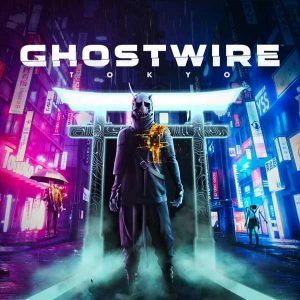Ghostwire Tokyo
(available for PlayStation 5 and PC)
(PlayStation 5 version used for review)
Ghostwire Tokyo has had a long and tricky development. I was first hearing about this game in 2019 and it has had numerous development issues in the time it’s taken to come out. It’s the latest game from Tango Gameworks, the studio created by Resident Evil creator Shinji Mekami, and prior to this, they had also made the two Evil Within games.
Now of course, this is a Bethesda owned studio, which means that now this studio is owned by Microsoft. But this was still part of a two-game deal that Bethesda had made with Sony to really prop up the PS5’s first year on the market. Although of course this game was hit with several delays in its development, hence it’s 2022 release. However, despite the Microsoft purchase, this will remain a PlayStation exclusive for at least a year- so Xbox owners will have a long time to wait before they can enjoy this game. Although I suspect Xbox owners will get to play this and Death Loop relatively soon.
I wasn’t a huge fan of Death Loop, I actually tried to review it, but it was a game that really didn’t pique my interest, and I really didn’t have any desire to continue playing it. Ghostwire Tokyo (as I previously mentioned) comes from the Evil Within team and that does interest me! As much as the first one didn’t do much for me, the minimal amount I played of the second one showed me that the studio was capable of growth, and I wondered what they would do with the PS5 technology. This is one of the few major Sony titles this year, whether it be from a third part or a first party, that would be PS5 exclusive and not receive a PS4 release- something I’ve often wondered if it has been holding back the developers of truly harnessing the console.
Ghostwire Tokyo, unlike Evil Within, is not a survival horror game; it’s an action horror game. You play as a young salary man named Akito, who’s rather unwittingly partnered with a spirit named KK, and now fights their way through an almost apocalyptic Tokyo after a fog has wiped out much of the population and has turned them into spirits. The cult behind this has kidnapped Akito’s sister, Mari, with the intention of using her for some kind of ritual- more on the story later on in the review because I do have quite a bit to say about it.
The combat is linked to a new power set that KK gives Akito, he uses spirit magic of one of three elements: wind, fire, and water. Each has different strengths and weaknesses and are used towards different ghosts that are wandering throughout deserted Tokyo. The game is also open world, so you are able to freely go about the map to a certain extent, you do need to cleanse various shrines in order to lift the fog which opens up more parts of the world. It’s a bit similar to filling in the map in Assassin’s Creed.
So how does the game stack up when all is said and done?
PROS
- Ghost design
While they’re not entirely original since many of them resemble Slenderman, and it’s very clear movies like The Grudge and particularly The Ring were big influences (to such an extent that a couple of them look exactly like Sadako from Ring) They are very well designed and very well put together, you can tell a lot of thought has gone into them.
A lot of people said that when this was being developed that they thought it might be similar to that of Silent Hill and be some sort of spiritual successor. It’s definitely not a spiritual successor in the tone, but it certainly takes some elements from Silent Hill in the ghost designs, because it has the idea of mixing the mundane with the macabre that that game developed. Although, Silent Hill did that in the way of expressing the main character’s innermost thoughts- the point of the world in that game was that it was meant to be their personal tailored hell for whichever character was to go into it. Ghostwire Tokyo isn’t going for that, it’s more going for something very different, but it does feel rather unnerving to have these faceless spirits wandering around this deserted Tokyo, almost like they’re re-enacting the lives they once lived and want to destroy you to not face the reality that they can no longer carry out those lives.
- Frame rate
For crying out loud, play this game in either Performance mode or particularly Performance V Sync mode (if you have a monitor that supports it) But whether you’re going for 60FPS option or you go for the higher frame rate option, you really should do so, because the frame rate is actually really good in this game. I barely noticed any frame rate drops or anything like screen tearing. It was amazing how well it all functioned together, the game is very well built especially considering the fact that the open world isn’t exactly small, the game does have to generate a lot going on. I found it remarkable how well it functioned.
MIXED
- Graphics
The graphics are fine, they worked very well, and they looked very good, but I wouldn’t exactly describe them as PlayStation 5 necessary. Graphically, I think that this game could function just fine on PS4 and this really goes to other points about the game, too. I don’t understand what part of this game is taking advantage of the PS5’s technology.
The major one I noticed was the fact that despite how big the open world is, when fast travel was used it had almost instant loading. And while the graphics were particularly good, I won’t exactly describe them as amazing. This game is built in Unreal Engine 4, and almost any game built in that engine is going to look good on some level, but I definitely would not say it matches up with a lot of the first party games that PlayStation has been bringing out themselves, particularly that of games like Returnal and Ratchet and Clank: Rift Apart.
The only other advantage I noticed it use was the haptic triggers of the PS5’s Dual Sense controller. But even then, it’s not the most amazing use of them. Speaking of which:
- Controls
While this game controls perfectly fine, you use the left triggers to aim and switch weapons, and the right triggers to fire. The controls can often feel quite sluggish at times, there was a whole bunch of times where I wanted to use the guard command, only to find it was a bit of a lucky draw to whether it would actually be pulled off in time. I also found it a bit stiff to do a full turn with my character. Now these are not game destroying! The game functions fine, and it does help that this game is phenomenally easy- I barely died in this game. But there were a few slight moments where I wished this game controlled better.
- Open world design
The game is attempting to recreate Tokyo, though the most recognisable areas of Tokyo that you can travel to during the early portions is the famous Shibuya district. That being said, there is a lot of great attention to detail here. I’ve actually been to Tokyo and in many ways, it really replicated my experience of being there.
You will not be taking the underground, you’ll be going everywhere on foot with a bit of gliding involved, and of course, parts of the map are cut off to you without cleansing shrines to remove fog. As a result, the game often feels a lot more linear than most open worlds do, it ends up cutting off parts of the world so that you unlock parts at specific times. Side quests are also held off without reason. This made me feel like you were just ticking things off as you go, and it doesn’t help that the map is really overloaded with icons from shops, shrines, locations for prayers to recover health, SP, etc.
There certainly is a lot to do but they end up repeating themselves quite a bit, and the open world is not the best to explore. For one thing, there are a lot of shrines that are on rooftops, and getting to these can be a puzzle! As a result, I often ended up wandering through the map looking for any high places I could find just to glide over in hopes that I’d hit the top of the roof. It certainly felt rewarding once you had got there, but this was not an open world that I felt that I really wanted to explore.
The map is also not incredibly huge, it’s about the size of an early Assassin’s Creed game in my opinion. The size of the open world was something that I was a bit worried about when I got the preload of this game and noticed that it was less than 20GB.. While my fears were not completely justified, there’s certainly something there.
- Game length
Now game length for me here is fine if you’re going for 100% completion, you’re looking at about 20 hours of gameplay. I don’t think that this game gives you much for your money though, if you’re like me and you’re just going for the main story with a few side quests along the way. Which I did! I did quite a few side quests on my route to it, but I was also getting rather jarred with the game and decided in the latter portion to just abandon it and only go for the main mission.
As a result, I beat the game in just over 10 hours, and again, I didn’t die that much! So, I’m not sure you’re getting as much content as you’d really like for a game that’s charging £50. It fortunately isn’t charging the full £70 that a Sony first party title would. If that was the case, I would have said in no circumstances purchase this- this game would not be worth £70. As it stands, I think it can justify a £50 price tag. But I also am not sure that the content of just the main story really feels like it makes the most of its time, I think in order to get the most out of the game you should really consider going for 100% completion, especially if this is going to be the only PS5 game you play for some time.
CONS
- Story
As mentioned, Ghostwire Tokyo is an action horror game, not a survival horror. So obviously, I wasn’t expecting to be really scared by this game. The best parts, in my opinion, are when you’re not in combat and you’re wandering through these rather trippy scripted events. There’s a lot of remnants of the ‘PT’ demo that was on PlayStation that I can see are influencing this one. It never reaches the heights of that, but there’s certainly a commendable effort put in.
Where it fails, however, is that the story is all over the place. The cult that causes the crisis are really not interesting as villains, I don’t even know what the plot is. They put so much into their motivations that they never really explain what they are actually doing and how kidnapping the main character’s sister is actually going to help them. Also, for as much emphasis that is put on rescuing her, they really don’t emphasise her character and her and Akito’s relationship until very near the end of the game, which I actually think are some of the best parts of the story and probably the biggest emotional crux in the whole plot, since Ghostwire a Tokyo is trying to tell a story about grieving over people that we lose.
But wow, it doesn’t really hit that note until the very end, which made me feel like it was too little too late. It was very well done but you needed to hit this note way sooner. It also doesn’t help that the characters feel half-baked, most of them only get slight character arcs, and as soon as it is done, they just disappear from the story. It almost feels like that bit from the Simpsons, “I have to go now, my planet needs me”.
- Side quest handling
The side quests in this game felt like such busy work; most of them don’t last very long and they’re mostly used to gain experience and money. But I don’t really understand why, because if you don’t do them, you’re still swimming in money. It also didn’t help that I gained a lot of money as a pre-order bonus in the game, so I was never short on healing items. Even then, I think that that’s another problem that the game has, it gives you far too many healing items and far too much money. You’re never going to be short on these items so you’re never going to potentially conserve, which obviously makes sense on some levels, it’s meant to be an action game, but I hardly ever felt jeopardy as a result.
I never even really tried much stealth apart from the few times I was cut off from my magic and I had to resort to using a bow and arrow, which really isn’t as effective a weapon as the game makes it out to be.
The game also has a ton of collectibles that you can trade in at some of the various cat stalls throughout town in exchange for big bonus pay-outs, but like I already mentioned, the game pays you out fairly already, so you don’t really need to do this. I ended the game with tons of cash left over. The side quests just feel like a lot of work, since for some of them you have to find the exact right artefact to take to a store, you can’t just go to a store and say, “I found this, gimme money”.
As a result, I really didn’t enjoy doing the side quests, I pretty much abandoned them really early on, since they were so repetitive, and they didn’t do anything to inform my opinion on the characters.
- Customisation options and upgrades
I don’t understand why this game even has customisation options. You’ll only be seeing them in the rare cutscenes, and they don’t really provide many stack differences. Again, I got a lot for my pre-order bonus, but I barely used any of them! I certainly didn’t go out of my way to do side quests to get any of them. The only customisation option that makes a difference are the various prayer beads that you can get, which can emphasise your abilities to a better degree. So, for example, you can have a bead that improves water magic or fire magic.
The upgrades really don’t feel like they add much, they certainly boost your abilities for levelling up but spending those skill points in the tech tree didn’t feel like it made much of a difference. I only really noticed it with things like gliding and gaining access to a few extra abilities, such as finishing moves to end fights quicker. As a result, it made the combat feel even less thought out and made it all feel like a bit of a chore. The combat is fine for the most part, but it’s nothing that interesting.
Ghostwire Tokyo is pretty much a purely average game. It’s not terrible, but I didn’t really have that much enjoyment going into it, and I think that’s because this game has a lot of half-baked ideas that needed a bit longer in the oven. I’m beginning to wonder if this was a case of too many people having too many ideas and no one really knew when to say stop.
If anything, I actually think that this game would have been better if it had been a more linear game and had stuck to more scripted moments. Those are the best moments in the game, and I think it would make for a good push for the upcoming VR support.
While Ghostwire Tokyo doesn’t really do anything wrong, (I personally have misgivings with the story and I find the combat very repetitive considering the upgrades don’t really do much), I wouldn’t exactly say it doesn’t do much right either. It doesn’t feel like this game was made with the PlayStation 5 in mind and it seems to really have an identity issue overall. The controls definitely could be better, in fact I would probably recommend the PC version to play with a keyboard and mouse, so you have better aim since the entire game is seen in first person.
I would say it doesn’t overstay its welcome, but it also feels like a game that doesn’t really do much that I enjoy about open world games, especially considering that there’s not much jeopardy to going round and exploring the open world- once you clear an area of ghosts they’re mostly gone forever.
I wouldn’t describe this game as a mess, but I wouldn’t describe it as great either. It’s perfectly average, but I don’t think I’ll be playing it again. I reckon you should wait for it to go on sale.
Score: 6.8/10
Nerd Consultant
Share This Post:








Leave a Reply